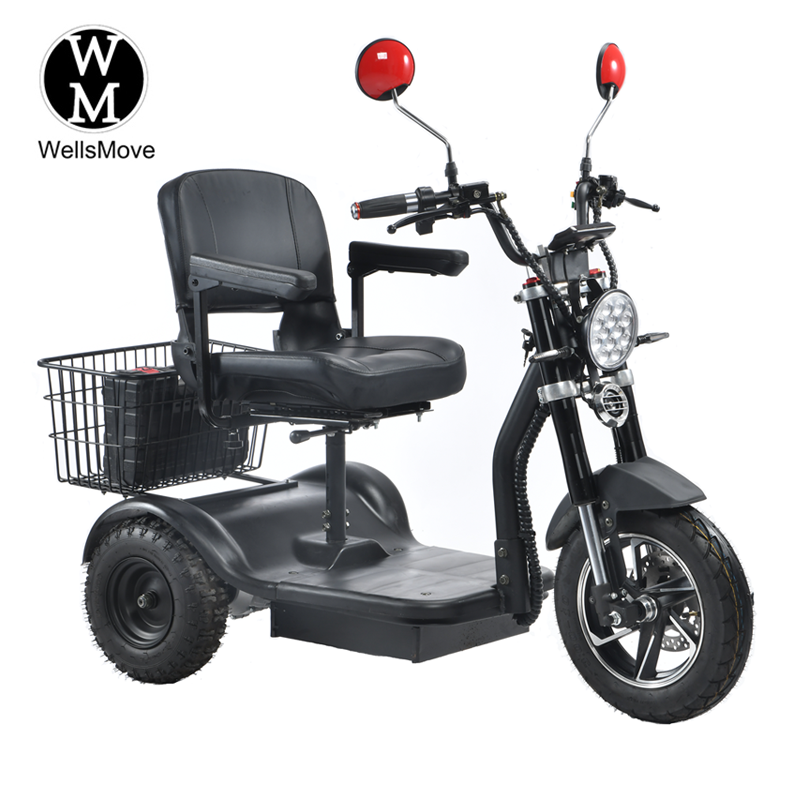Ergonomic Design Optimization of Senior Three-Wheeled Mobility Scooters: Ensuring Comfort and Safety for Elderly Travelers
With the accelerating global aging population, the mobility needs and pursuit of quality among seniors are increasing. As a convenient means of transportation, the design of senior three-wheeled mobility scooters tailored to their physical characteristics directly impacts the user experience and safety. Ergonomic design is key to addressing the driving pain points faced by seniors and enhancing product competitiveness. This article will analyze the ergonomic optimization strategies for senior three-wheeled mobility scooters from four core perspectives: seating, controls, body, and shock absorption, to create a more adaptable and secure travel companion for seniors.
I. Addressing the Driving Pain Points of Seniors: The Necessity of Ergonomic Optimization
Due to physiological changes, seniors face many unique challenges when using mobility scooters: Lumbar disc herniation and joint stiffness can lead to back pain after prolonged rides; decreased vision and manual dexterity make complex controls difficult to accurately operate; and impaired balance can lead to discomfort and even safety risks on bumpy roads. Traditional mobility scooters often overlook these characteristics, resulting in problems like hard seats, heavy controls, and cramped space. These issues not only diminish the user experience but also pose potential safety risks.
The core of ergonomics is user-centricity. By studying the body dimensions, movement habits, and physiological tolerances of older adults, scientific data is translated into design solutions. For example, seats are optimized based on the average hip width and lumbar curve of the elderly population, and control button feedback is adjusted based on hand grip strength. The ultimate goal is to achieve “comfortable seating, easy operation, and stable riding”—this is crucial for improving product user reputation and providing a core competitive advantage in the international trade market.
II. Seat System Optimization: From “Sitability” to “Long-Term Sitting without Fatigue”
The seat is the part of the mobility scooter that older adults spend the most time in contact with, and its ergonomic design directly determines ride comfort. Optimization should focus on three key areas: support, fit, and adjustability, adapting to the fatigue-prone bodies of the elderly:
1. Backrest and seat design that conforms to physiological curves
Lumbar support: The weight-bearing capacity of the lumbar spine decreases in the elderly. Therefore, the backrest should be equipped with a lumbar support that conforms to the physiological curvature of the human spine. The height corresponds to the third to fifth lumbar vertebrae (approximately 18-22cm from the seat cushion). The backrest should be padded with elastic foam to distribute lumbar pressure while avoiding inadequate support caused by being too soft. Furthermore, the backrest angle can be adjusted from 105° to 115°, accommodating both a natural sitting position and a slightly reclining position for resting, reducing lower back muscle tension.
Seat Cushion Material and Size: The seat cushion utilizes a combination of high-density memory foam and breathable mesh. The memory foam automatically conforms to the hip curve based on weight distribution, distributing pressure on the ischial spine (avoiding localized pressure and numbness). The breathable mesh alleviates the issue of stuffiness caused by prolonged sitting in the summer. The seat cushion width should accommodate the average hip width of the elderly (approximately 45-50cm), with 2-3cm of free space on either side to avoid legs being squeezed by the seat being too narrow or body movement being caused by being too wide.
2. Detailed Protection Design
Armrests and Headrests: The armrests are set at a height of 70-75cm (adapting to the natural arm rest height of an elderly person when sitting). They feature a curved, soft cushioning for support when getting in and out of the vehicle. The headrest is adjustable from 38-45cm to contour to the curve of the neck, preventing neck pain caused by head movement during driving, making it particularly suitable for long journeys.
Anti-Slip and Secure: The seat cushion surface features subtle anti-slip grooves to prevent slipping during braking or cornering. Additional secure buckles are located underneath the seat, providing a secure connection to the vehicle body and preventing seat movement during driving, enhancing safety.
III. Control System Optimization: Making Complex Operations Easier
Seniors experience varying degrees of decline in hand dexterity, strength, and vision. Therefore, the control system must adhere to the principles of “minimalism, effort reduction, and visualization” to lower the barrier to entry:
1. Design of Effort-Reducing Control Components
Steering Wheel/Handle: Traditional round steering wheels require significant steering effort. This optimized design features a curved power-assisted handle with a grip diameter of 3.5-4cm (compatible with the fist size of an elderly person). The handle is coated with non-slip silicone and offers a steering resistance of ≤5N (approximately 0.5kg), making it easy for even those with limited hand strength to steer. Furthermore, the handle is flush with the seat armrest, eliminating arm lifting or bending, reducing shoulder strain.
Buttons and Switches: Function buttons have a diameter of ≥3cm (for easier identification for those with low vision), a raised height of 1.5mm (for clear tactile feedback), and a pressing force of ≤3N (50% less than traditional buttons), preventing finger soreness from excessive pressure. Core functions (start, brake, and lights) are clustered near the handlebars, spaced ≥5cm apart to prevent accidental touches. Buttons are labeled with large fluorescent font (e.g., “Start” and “Stop”) for clear identification even at night.
2. Visual and User-Friendly Feedback
Instrument Panel: Complex data displays are eliminated, retaining only the three core information components: speed, battery level, and fault indication. Font size ≥18 point, with high-contrast color schemes (white text on a black background or black text on a yellow background), are optimized for elderly vision. Furthermore, the instrument panel is tilted 15°-20°, aligning with the natural downward angle of vision, eliminating the need to look down or up, and reducing neck strain.
Brake Feedback: A “progressive braking” design is employed, with the first third of the brake pedal travel providing light braking (gradual deceleration) and the last two-thirds providing strong braking (rapid stopping), preventing the body from leaning forward due to sudden braking. When braking, a red warning light illuminates on the instrument panel, accompanied by slight vibration feedback, providing dual reminders of the vehicle’s operating status.
IV. Body Space and Entry/Exit Design: Meeting the Convenience Needs of Individuals with Mobility Issues
Joint stiffness and insufficient leg strength often make it difficult for seniors to get in and out of vehicles, and cramped interiors are common challenges. The body space design should be optimized for ease of entry and exit, ample space, and ease of access:
1. Low Threshold and Wide Doors
Threshold Height: The threshold height is reduced to 15-18cm (20% lower than traditional mobility scooters), approaching the height of a sitting senior’s feet, allowing entry without significant leg lift. The threshold width is ≤8cm to minimize weight loss when stepping on the vehicle.
Door Design: The door opening angle is ≥90°, and the width of each door is ≥65cm. Combined with the outward-folding armrests (120°), this creates a wide aisle for entry and exit, making it easy for even those with crutches or walkers to enter and exit. 2. Interior Space
Legroom: Legroom in front of the seat is ≥60cm, allowing seniors to sit with their legs extended naturally (avoiding tight knee bends that can impede blood circulation). A 10cm adjustment margin is also provided to accommodate seniors of varying heights (150-180cm).
Storage and Assistance: Foldable storage pockets (≥5L capacity) are located on the side of the seat for convenient storage of water bottles, medicine, and other personal items. The pocket opening is flush with the armrest, eliminating the need to bend over. Concealed power handles are added on both sides of the vehicle for hand support when getting in and out of the vehicle, reducing the weight on the legs.
V. Optimized Shock Absorption and Stability: Ensuring a Sense of Security on Complex Roads
Seniors have poor balance abilities, and bumpy roads can easily cause dizziness, discomfort, and even increase the risk of rollovers. The shock absorption and stability design must balance vibration reduction and driving stability, adapting to road conditions in diverse regions around the world (e.g., European cobblestone roads, rural dirt roads in Southeast Asia):
1. Multi-dimensional shock absorption system
Suspension structure: Double wishbone independent suspension is used in the front wheels, while coil spring shock absorbers are used in the rear wheels. Combined with shock absorbers with a 2.5cm travel, they can filter out over 80% of minor bumps (such as road joints and small stones). The shock absorber damping coefficient is tuned to be soft (suitable for low-speed driving), and the vehicle body movement during driving is ≤3cm to avoid severe shaking.
Tire selection: 16-inch wide tires (tread width ≥12cm) with a tread depth ≥3mm are used to enhance grip while further cushioning bumps through tire elasticity. Tire noise is controlled below 60 decibels (10 decibels below the industry average) to reduce noise irritation to the elderly’s hearing. 2. Stable Body Design
Optimized Center of Gravity: The battery pack (the core weight component of the mobility scooter) is mounted below the center of the vehicle, keeping the vehicle’s center of gravity ≤50cm (15% lower than traditional mobility scooters). The vehicle’s roll angle during cornering is ≤10°, minimizing the risk of rollover. The vehicle’s width is ≥70cm, with a wheelbase that matches shoulder width, ensuring greater stability during driving.
Low-Speed Safety: The maximum speed is limited to 15km/h (in line with the speed limits for mobility scooters in most countries worldwide). Acceleration utilizes a “linear acceleration” process (0-10km/h acceleration time ≥3 seconds) to prevent sudden acceleration that could cause the body to lean back, making it easier for seniors to control the vehicle’s speed.
VI. Foreign Trade Compliance and User Verification: Ensuring Optimized Designs Stand the Test of the Global Market
As an export product, the ergonomic design of the elderly tricycle must meet both user experience and international compliance:
Compliance: Materials selected must comply with EU CE and US FDA certification standards. The seat sponge is formaldehyde- and heavy metal-free, and plastic components are made of food-grade PP to minimize health risks from long-term contact with the elderly. The control system complies with ISO 12100 mechanical safety standards, and buttons, handles, and other components have no sharp edges to prevent scratches.
User Verification: Optimization solutions must be tested with elderly populations in different regions. For example, seat height and legroom are adjusted to accommodate the taller average height of European seniors, while seat ventilation and rust-proofing are enhanced for the humid and hot climate of Southeast Asia. By collecting feedback from global users (e.g., “Insufficient lumbar support” and “Heavy brake force”), continuous iteration and optimization are conducted to ensure the design is suitable for diverse market needs.
Conclusion: Protecting Elderly People’s Right to Travel with Ease Using Ergonomics
The ergonomic design optimization of senior three-wheeled mobility scooters is more than just a matter of “adding details,” but rather a deep respect for the mobility needs of the elderly. From the seat that conforms to the lumbar spine, to the easy-to-use controls, to the smooth and comfortable ride, every optimization is designed to ensure seniors feel “safe, comfortable, and at ease.”
Post time: Sep-15-2025



